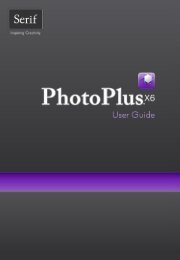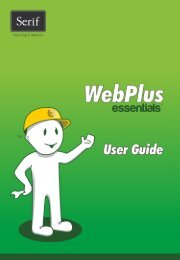Create successful ePaper yourself
Turn your PDF publications into a flip-book with our unique Google optimized e-Paper software.
Painting and Drawing 95<br />
Intersect—includes the intersection area only when a new shape is<br />
added onto existing selected shapes on the currently selected layer.<br />
Exclude—excludes the intersection area when a new shape is added<br />
onto existing selected shapes on the currently selected layer.<br />
You can alter a shape layer’s transparency using the Layers tab, or apply effects like<br />
bevel or drop shadow by choosing Effects… from the Layers menu (or via the Add<br />
Layer Effects button on the Layers tab). Painting tools and adjustment filters don’t<br />
work on shape layers; you’ll first need to convert the layer to a bitmap layer first<br />
(right-click the layer name and choose Rasterize).<br />
To align or distribute shapes on different layers, select multiple layers with Ctrlclick<br />
or Shift-click then choose Align or Distribute options from the Layers menu.<br />
You can choose to align tops and bottoms, and so on.<br />
Creating and editing QuickShapes<br />
QuickShapes in <strong>PhotoPlus</strong> are pre-designed, filled contours that let you can<br />
instantly add all kinds of shapes to your page, then adjust and vary them using<br />
control handles—for innumerable possibilities!<br />
The QuickShape Tools flyout lets you choose from a wide<br />
variety of commonly used shapes, including boxes, ovals,<br />
arrows, polygons, and stars. Each shape has its own built-in<br />
“intelligent” properties, which you can use to customize the<br />
basic shape.<br />
Quickshapes can also be drawn as paths as described<br />
elsewhere in Using paths (see p. 103).
















